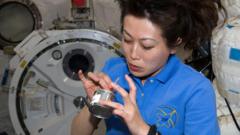In the heart of Iceland, beneath the shadow of the nation’s largest geothermal power facility, a revolutionary agricultural venture is taking root. Vaxa Technologies has transformed a large warehouse into a modern indoor farm, where microalgae bloom under an enchanting pink-purple light. As I step inside this futuristic haven, General Manager Kristinn Haflidason enthusiastically guides me through the intricacies of this innovative food production method.
Historically, humans have consumed macroalgae, particularly seaweed, but microalgae have yet to achieve wide acceptance, despite their rich nutritional profile. Vaxa specializes in producing the microalgae Nannochloropsis, intended for both human consumption and as feed in aquaculture. They also cultivate Arthospira, known as spirulina, prized for its health benefits.
The unique integration of algae cultivation with a nearby geothermal power station sets Vaxa apart. This facility employs renewable energy and provides nutrients along with CO2 emissions to enhance algae growth. This synergy allows Vaxa to establish a process described by food technology consultant Asger Munch Smidt-Jensen as carbon-negative, which lowers the environmental impact associated with traditional food production methods.
Advanced technology plays a critical role in optimizing this production. Using photo-bioreactors lit by LED lights, the algae flourish in carefully controlled conditions that mimic sunlight, maximizing photosynthesis. Vaxa’s facility is designed to produce an impressive 150 metric tonnes of algae annually, with hopes for future expansion.
Not only do the microalgae boast a considerable amount of protein, omega-3s, vitamins, and fatty acids, but they also represent a sustainable option for addressing growing food insecurity worldwide. With projections indicating the microalgae market could surpass $25 billion by 2033, Vaxa is at the forefront of a food revolution, alongside emerging companies such as Danish start-up Algiecel, which is exploring portable algae farming units linked to CO2 emissions from industrial sources.
As promising as microalgae are, experts acknowledge challenges remain. The culinary acceptance of microalgae is still in question, with taste and texture being potential barriers to widespread adoption. Food scientist Malene Lihme Olsen emphasizes the need for further research to improve its digestibility and palatability. She suggests integrating microalgae into familiar food products, like breads or pastas, to enhance their acceptance.
Back at Vaxa, I observe the harvested microalgae, ready for processing. Mr. Haflidason offers me a taste of the harvested product, which has a neutral flavor resembling tofu. He reassures me that the goal isn't to consume green sludge directly, but rather to incorporate its nutritional benefits into everyday food items. In Reykjavik, local businesses have begun utilizing spirulina in various products, demonstrating the versatility of these microscopic powerhouses.
Vaxa Technologies exemplifies how innovative practices, bolstered by renewable energy, can reshape the future of food production while addressing pressing sustainability issues. As the world grapples with the dual challenges of food security and climate change, initiatives like Vaxa’s could herald a new era of food cultivation, making microalgae not just an alternative but a staple in our diets.
Historically, humans have consumed macroalgae, particularly seaweed, but microalgae have yet to achieve wide acceptance, despite their rich nutritional profile. Vaxa specializes in producing the microalgae Nannochloropsis, intended for both human consumption and as feed in aquaculture. They also cultivate Arthospira, known as spirulina, prized for its health benefits.
The unique integration of algae cultivation with a nearby geothermal power station sets Vaxa apart. This facility employs renewable energy and provides nutrients along with CO2 emissions to enhance algae growth. This synergy allows Vaxa to establish a process described by food technology consultant Asger Munch Smidt-Jensen as carbon-negative, which lowers the environmental impact associated with traditional food production methods.
Advanced technology plays a critical role in optimizing this production. Using photo-bioreactors lit by LED lights, the algae flourish in carefully controlled conditions that mimic sunlight, maximizing photosynthesis. Vaxa’s facility is designed to produce an impressive 150 metric tonnes of algae annually, with hopes for future expansion.
Not only do the microalgae boast a considerable amount of protein, omega-3s, vitamins, and fatty acids, but they also represent a sustainable option for addressing growing food insecurity worldwide. With projections indicating the microalgae market could surpass $25 billion by 2033, Vaxa is at the forefront of a food revolution, alongside emerging companies such as Danish start-up Algiecel, which is exploring portable algae farming units linked to CO2 emissions from industrial sources.
As promising as microalgae are, experts acknowledge challenges remain. The culinary acceptance of microalgae is still in question, with taste and texture being potential barriers to widespread adoption. Food scientist Malene Lihme Olsen emphasizes the need for further research to improve its digestibility and palatability. She suggests integrating microalgae into familiar food products, like breads or pastas, to enhance their acceptance.
Back at Vaxa, I observe the harvested microalgae, ready for processing. Mr. Haflidason offers me a taste of the harvested product, which has a neutral flavor resembling tofu. He reassures me that the goal isn't to consume green sludge directly, but rather to incorporate its nutritional benefits into everyday food items. In Reykjavik, local businesses have begun utilizing spirulina in various products, demonstrating the versatility of these microscopic powerhouses.
Vaxa Technologies exemplifies how innovative practices, bolstered by renewable energy, can reshape the future of food production while addressing pressing sustainability issues. As the world grapples with the dual challenges of food security and climate change, initiatives like Vaxa’s could herald a new era of food cultivation, making microalgae not just an alternative but a staple in our diets.





















